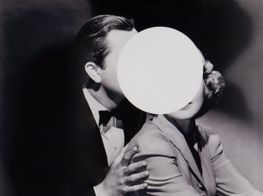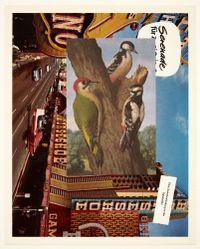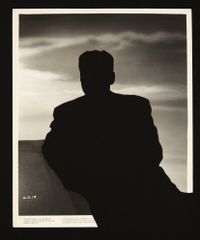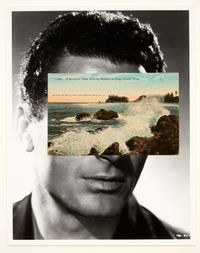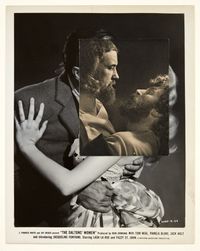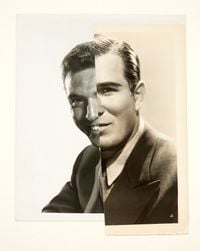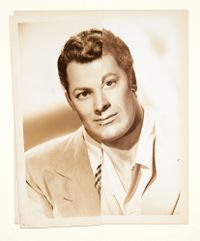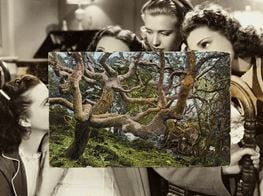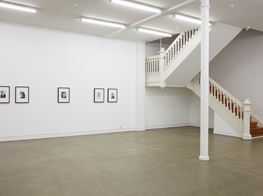John Stezaker

John Stezaker is an artist who has worked through ideas around the nature of images for some 40 years, and who, while developing his practice in the late-1960s and 70s, made the decision to retreat from the art world, becoming a teacher in historical and contextual studies at the Royal College of Art in London. The reason for his retreat was the fact that people did not understand what he was doing during the 1970s. 'People were mystified by it,' he explained as we sat down for a conversation around an upcoming exhibition at the Anna Schwartz Gallery in Sydney, in which Stezaker will be showing the full selection of works that was made for the 19th Sydney Biennale (not all of it could fit into the space in the end). 'I was getting labelled as a kind of latter-day surrealist, which wasn't very helpful, and being put in a strange eccentric pigeonhole. So I thought it was easier for me to carry on my work without exhibiting, without the constant challenge of public opinion.'
It was at the turn of the millennium that Stezaker suddenly experienced a massive wave of interest—Charles Saatchi began collecting him, he had numerous gallery shows around the world, and a retrospective at the Whitechapel Gallery in 2011, followed by the Deutsche Börse Photography Prize in 2012 and a major participation in the 19th Sydney Biennale. The rest, as they say, is art history. Some four decades on, Stezaker continues to develop his practice with a singular approach that he reflects upon in this interview, which also explores how his ideas around the image have changed over the years.
SBWhat you will be showing in your next show at Anna Schwartz?
JSThe work I am showing, which was intended to act as an introduction to Australia when it was put together for the Sydney Biennale, has its roots from 35 years ago, so it's not exactly new work—the 'Masks, Marriage, Third Person Archives' series were all started in the mid-to-late seventies, and most of my work has developed from the conceptual seeds that were sown back then. New series emerge, of course, but I had already cemented the basic ideas.
SBYou have said that your retreat from the art world in the seventies was related to how surrealism was unfashionable at the time, which reminds me of Duane Michals once said that to produce narrative work during this time was a kiss of death!
JSI couldn't agree more. The unconscious at the time was completely taboo you see, and narrative was part of that taboo. Surrealism was the kind of thing you would see on advertising posters in the seventies. Culturally it was at its most debased. But in a way—and I thought this was very significant —it felt like art was taking a step against the unconscious through conceptualism. Of course, what we discovered was that by trying to maintain that conscious control, things had to be sacrificed: narrative, the unconscious, and meaning—the most fundamental things.
At the time, I felt like all of art was heading into this cul-de-sac and there was a need for some kind of a reverse. I could feel that there was an aspect of Pop art that hadn't fully explored a relationship with the found image, but I felt that this had to connect with surrealism, for me—to the unconscious and the unknowable. But of course, trying to produce work in a climate completely antipathetic to the idea of the unconscious or the unknowable, even less mystery, just felt like this cumulative impossibility in that people really could not gain an understanding of what I was trying to do, so I thought it was best to get on with my life.
SBWhen you think back to that time, was there a core message you were attempting to communicate?
JSI said this a lot—though I'm not sure if I still believe it: that there were enough images in the world already, and for me it was really about negotiating through this multiplicity. I didn't want to produce any more images, but I wanted to find a way of cutting through that volume through collage.
Another thing was that the word collage was very important to me. I later discovered that the American appropriators, Richard Prince included, weren't using the word collage at the time because it had to be about this kind of Duchampian conceptual appropriation. I was more interested in collage because it opened the possibility of discovering things that weren't conceptually pre-ordained, and this was the limitation I found in the so-called New Image appropriation movement in America: that it knew what it was doing too much, even though what was interesting in what they were doing was the unknowable part! That didn't seem to be recognized: American critics who supported them were almost in denial of that fact. It took the Europeans, people like Sigmar Polke, to really make those connections that I was looking for.
SBOf course, because you were very much influenced by the Capitalist Realists: Sigmar Polke and Gerhard Richter, as a student...
JSYes, that's right. I'd seen them as a way out. In fact, as a student, I went penniless to see the show in Berlin at René Block. This was in the late-sixties, and I arrived with the hope of meeting my heroes, only to discover that the openings happened the night before!
But in terms of influence, I didn't want to go that way either. At the time, I had joined the painting department at the Slade, and I had realised that everything I did with paint was useless—that's why I went to see the Capitalist Realism exhibition. I had to see Gerhard Richter's 'Politburo' series as I'd only seen it in reproduction. But when I saw it I was slightly disappointed. What Polke and Richter had was a public and political relationship to the found image, and I wanted something that had to do with secluding the found image and taking it out of circulation and out of its various spheres of meaning. Come to think of it, the seclusion of the found image was a mirror of my own seclusion that developed around that time.
So after seeing this show I returned to London with a quite definite idea that painting was not the answer for me, so I started to make films. I was also in a bit of a dilemma. I felt more and more strongly that if I was going to find my path—because I was changing week after week as a young student and was definitely forging a path no one else was on—I really needed to be uninterrupted and unaffected by the forces of the art world. I realised that I was very affected by other people's opinions, so gradually I found this modus operandi of working as a teacher and working as an artist out of view.
SBDid the teaching help you flesh out or solidify ideas?
JSQuite right. I've always said this to students, especially when writing their dissertations, that very often I've found by working through an idea purely theoretically, you can jump stages in your own development. You can actually cut through a lot of that sitting around waiting for things to happen. And it's very useful actually to write thoughts out. So yes, I did develop from teaching, but equally, my work was an escape from it. I would spend my time seeped in philosophical and aesthetic thinking in my daytime activities, and then at night I would completely escape.
SBYou have said of working at night, that this is when the unconscious really takes over, and that when this happens, you become a viewer of your own production.
JSI think I wouldn't have placed so much emphasis on that part of making if I hadn't been teaching art history and theoretical studies, because I would have had a slightly more integrated sense of the intuitive and the conceptual. My art became purely this escape from the conceptual and consciousness, actually. It became about allowing things to happen. Of course, it's important that I was working at night, after work, when I was tired. And that tiredness allows you a release from the shackles of conscious control, and allows things to appear before you. I always feel that my work gets going when I'm not in control. It's a paradox, really. You can only see things when you abandon things. So oftentimes, it happens that after an evening of totally frustrated activity, I suddenly see something that works from the corner of my eye.
SBIn your definitions of the terms collage and montage, you have said that collage is about making something illegible and interrupting the seam, while montage is about making something seamless—how does this relate to film? Is your film work an antidote to your collage work?
JSI mean, these are purely my own distinctions, but I tend to think about it as the difference between Eisenstein and Vertov—the showing of the seams in Vertov and the suppression of the seams in the continuity of Eisensteinian montage. Of course its that seamless continuity which becomes the Hollywood mainstream. I've made four films now, the best-known of which is called Blind, consisting of one after the other film stills from my collection in the order that they come out of my collection. Each film still is projected at 1/24th of a second. All of my films up till now consist of still images projected in this way, at 1/24th of a second. These films are deliberately discontinuous. You can't apprehend an image at this speed. So what you happened to see will vary. Every time you watch the film you see a different film: it's never the same. This is completely the antithesis of cinema, which is about incremental difference: following the image. It is a fractured cinema—image fracture rather than integration I suppose.
SBThis relates to the cut. You've said in the past that there said there is something very violent and surgical to cutting images in your work; bodily almost.
JSMost people can't tell the difference between my early and my later work, but I feel there is a total difference. In my earliest work there is this emphasis on cutting in the bodily sense. The very first words I used to describe my collages were incisions or excisions: the surgical metaphors. Excision is the surgical name for the removal of the eye. They had a very strong violence, which, in some ways, I now find difficult to relate to.
Later, I produced a kind of reparation to that violence with the 'Love' series, which emerged out of the series I'd done before called 'Blind', in which I'd removed the eyes in portraits, cut through them and overlapped them. By doubling the eyes through the cut the 'Love' series were a kind of reparation for me.
In thinking about the cutting, I think there is always violence in a cut—though sometimes it is emphasised more—and I think the image, in a way, always has to be interrupted to be revealed. The seam has to be exposed to see the inherent violence of the cinematic image. You have to be aware of the nature of the image as fragment, and of the point in which the image abutts with nothingness, to be aware of the image-as-image
This seems to be a relationship with the image that is both an experience of loss and somehow a connection with desire. I'm obviously an image fetishist, and the desire in image fetishism relies on seeing the image as a whole as well as seeing both into it and through it. In my own image fascination, I think of it as being attached to the 'death's space' of the image as opposed to its life space. The life space of an image is its currency: the way a particular trait represents a known personality, or if it's an unknown personality you can see things from the period in which the image was taken. There are various ways you can see it and this is it's transparency. The opacity of the image is the mystery, peculiarity and strangeness of it—that unknowable part. And my work always needs to have that connection to the unknowable.
SBHow might you summarise your practice at this point?
JSI don't think it's possible. My work has been about an abandonment to the fragment. I think I started a long time with an idea—that there are too many images in the world and I needed to find a way to negotiate the space between images, but I couldn't give myself any kind of agenda as broad as that anymore. I'm so enmeshed in what I do and my feeling is that I know less and less about what I do. The further I get and the more adept I am at actually working with collage, the less I feel I know about what the processes are and the more mysterious they become to me, strangely.
I know this sounds like the kind of thing you'd expect someone to say, but it's the truth and it's scary. It's not something I enjoy, because the whole time I'm trying to get to some sort of sense of what I'm doing. I'm not complacent about the unknowability of it all—quite the contrary.—[O]

